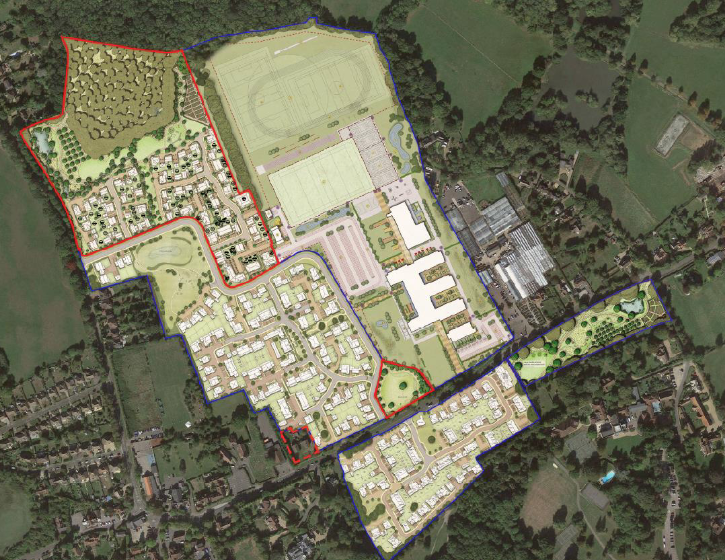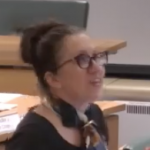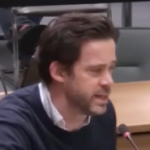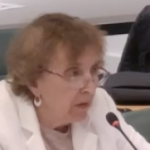 Abraham Lincoln
If given the truth, the people can be depended upon to meet any national crisis...
Abraham Lincoln
If given the truth, the people can be depended upon to meet any national crisis...
 Guildford news...
for Guildford people, brought to you by Guildford reporters - Guildford's own news service
Guildford news...
for Guildford people, brought to you by Guildford reporters - Guildford's own news service
Permission Refused for Additional 114 Houses to Make Howard of Effingham Scheme Viable
Published on: 2 Apr, 2022
Updated on: 4 Apr, 2022

Aerial view of the Howard of Effingham site. It was proposed that an additional 110 (of 114) houses would be added to the existing scheme at the top of the largest parcel of land outlined in red above. Image form GBC report.
By Martin Giles
A planning application for a further 114 houses in the planned redevelopment of the Howard of Effingham School was refused by a single vote at Guildford Borough Council this week because of the impact it would have on the green belt.
The developer, Berkeley Homes said, said at the meeting (March 30) that the extra homes were necessary to make the scheme viable and provide the funding required for expanded facilities at the secondary school, including some for pupils with special needs.
Planning officers recommended approval, subject to conditions. In a presentation, John Busher a principal GBC planning officer said the acknowledged “harms” caused by the extra development would be outweighed by the benefits.
Effingham parish councillor Bronwen Roscoe complained of the non-disclosure of key documents and said that evaluation by officers of harms versus benefits was not correct.
This was echoed by Ian Smith, vice chairman of the Effingham Residents’ Association. He pointed out that there had been only seven comments in support of the application but over 600 objections and others, including his, which he claimed had been somehow lost.
Mr Smith said: “Berkeley Homes has used the issue of viability to hold you, the local authority, and the residents of Effingham to ransom for the building of a new school. This is not right.”
John Rhodes a planning consultant employed by the developers said that the situation reminded him of the successful 2017 appeal which allowed permission for the original scheme to proceed [ie the building of 295 new homes which would fund the redevelopment of the school]. “The inspector and the Secretary of State found that the benefits clearly outweighed the harm,” he said.
Rhona Barnfield, a former headteacher at the Howard of Effingham school and now CEO of its Trust spoke in support of the motion saying that the school had struggled for over a decade to fund the required facilities. The Berkeley Homes scheme was the “only option” she concluded.
An expert on viability, Anthony Lee, consulted by GBC said that the amount of money the scheme would make had been reassessed and he had found: “…the amount of money [that would be] made available from the construction of the [additional] housing is the minimum necessary to deliver the school…”
Cllr Paul Spooner (Con, Ash South & Tongham) said he agreed with the view put forward by John Rhodes that the appeal decision on the original scheme had not been finely balanced and that if this application were appealed, Surrey County Council would be very supportive to the developer.
He said: “This is green belt and the Local Plan was adopted to protect green belt…and this is clearly having harm.” But he continued: “We are where we are. We have a viability assessment that supports the developer also supported by the officers of this council.” He would support approval.
Cllr Will Salmon (Lib Dem, Onslow) shared expressed concerns about the viability report. He said: “It seems either the sums were wrong to start with or the sums are wrong now but either way we don’t seem to know because there is no transparency.”
The 13 member planning committee voted seven to six against a motion to allow the application.
After the meeting, the ward councillor for Effingham, Liz Hogger (Lib Dem), who spoke against the proposal at the planning meeting, told The Dragon: “I think the planning committee meeting was an example of local democracy at its best. We had excellent contributions from public speakers on both sides of the argument, and committee members made thoughtful contributions and came to the right decision.
“The economic climate has changed massively since the original scheme was allowed at appeal. My hope now is that Berkeley Homes and the Howard School will revisit the various options available, and work with Effingham Parish Council and local residents to find a way of delivering a new school without such a devastating impact on our green belt and village.
“For example, would it now be more cost-effective to refurbish and remodel the substantial brick-built buildings on the current site, with some new build to replace the substandard ones and provide the Cullum Centre? If that could be paid for by fewer ‘enabling’ houses on our green belt, then everyone would benefit.
“I urge the Howard School and Berkeley Homes to come and talk to us so we can work together on this and avoid another confrontational appeal to the Planning Inspectorate.”
Local campaigner, Helena Lawrence commented: “Rumour was it was being approved so it was a tense wait to see the verdict.
“Berkeley Homes can appeal [the council’s decision to refuse] and go to Secretary of State again as they did with original 295 home planning application and new school.”
Responses to Permission Refused for Additional 114 Houses to Make Howard of Effingham Scheme Viable
Leave a Comment Cancel replyPlease see our comments policy. All comments are moderated and may take time to appear.
Recent Articles
- Guildford Institute’s Crowdfunding Project for Accessible Toilet in its New Community and Wellbeing Centre
- Letter: Guildford – Another Opportunity Missed?
- Letter: GBC’s Corporate Strategy – Where Is the Ambition?
- My Memories of John Mayall at a Ground-breaking Gig in Guildford Nearly Six Decades Ago
- Westborough HMO Plans ‘Losing the Heart of the Street’ Says Resident
- College Invests to Boost Surrey’s Economy and Close Digital Skills Gap
- Community Lottery Brings Big Wins for Local Charities
- GBC Housing Plan Promises ‘A Vibrant Urban Neighbourhood’ Near Town Centre
- Hospital Pillows ‘Shortage’ at the Royal Surrey
- Updated: Caravans Set Up Camp at Ash Manor School


Recent Comments
- Ian Macpherson on Updated: Main Guildford to Godalming Road Closed Until August 1
- Sara Tokunaga on GBC Housing Plan Promises ‘A Vibrant Urban Neighbourhood’ Near Town Centre
- Michael Courtnage on Daily Mail Online Reports Guildford Has Highest-paid Council Officer
- Alan Judge on GBC Housing Plan Promises ‘A Vibrant Urban Neighbourhood’ Near Town Centre
- John Perkins on GBC Housing Plan Promises ‘A Vibrant Urban Neighbourhood’ Near Town Centre
- S Collins on GBC Housing Plan Promises ‘A Vibrant Urban Neighbourhood’ Near Town Centre
Search in Site
Media Gallery
Dragon Interview: Local Artist Leaves Her Mark At One of England’s Most Historic Buildings
January 21, 2023 / No Comment / Read MoreDragon Interview: Lib Dem Planning Chair: ‘Current Policy Doesn’t Work for Local People’
January 19, 2023 / No Comment / Read MoreA3 Tunnel in Guildford ‘Necessary’ for New Homes, Says Guildford’s MP
January 10, 2023 / No Comment / Read More‘Madness’ for London Road Scheme to Go Ahead Against ‘Huge Opposition’, Says SCC Leader
January 6, 2023 / No Comment / Read MoreCouncillor’s Son Starts Campaign for More Consultation on North Street Plan
December 30, 2022 / No Comment / Read MoreCounty Council Climbs Down Over London Road Works – Further ‘Engagement’ Period Announced
December 14, 2022 / No Comment / Read MoreDragon Interview: GBC Reaction to the Government’s Expected Decision to Relax Housing Targets
December 7, 2022 / No Comment / Read MoreHow Can Our Town Centre Businesses Recover? Watch the Shop Front Debate
May 18, 2020 / No Comment / Read More














Jules Cranwell
April 3, 2022 at 6:12 am
Again we have Cllr Spooner claiming his Local Plan “protects the green belt”. Not in the 14 villages robbed of green belt protection it doesn’t. We won’t be fooled again.
John Perkins
April 3, 2022 at 7:46 am
Paul Spooner tells us that “the Local Plan was adopted to protect green belt” which is worth a hollow laugh or two.
However, he goes on to tell us “We are where we are”, which seems to mean we have to accept the loss of green belt because it’s a done deal.
Paul Spooner
April 3, 2022 at 7:11 pm
Mr Cranwell should know, given his long opposition to the local plan process, that it is a directive under that process to remove settlement areas from the green belt by insetting them.
That was what was correctly undertaken in the Guildford Local Plan. During the process, we looked carefully to see where we could wash over areas that could not be described as settlement areas. Hence some areas were not inset where that was justified within the planning process.
To follow Mr Cranwell’s approach would have made the Local Plan unsound and the examining inspector would not have supported adoption.
I am sorry but those are the facts. Protecting the vast majority of AONB and green belt has held since April 2019, a success for the Local Plan, in my opinion.
Paul Spooner was the leader of Guildford Borough Council when the Local Plan was adopted in 2019 and is the Conservative borough councillor for South Ash & Tongham.
Jim Allen
April 4, 2022 at 12:05 am
Perhaps Cllr Spooner could identify the “directive” forcing the council’s action? My understanding, having read considerable amounts of information on the subject, is that while there is a function to change from “washed over” by the green belt to “inset” in the green belt, there was no “demand by directive” that it should occur. I do accept the logic of doing it. Most other local authorities’ Local Plans around London did this in the early 2000s.
Jules Cranwell
April 4, 2022 at 6:08 am
Cllr Spooner appears to be in a minority of one. I have not met anyone outside of GBC who believes his plan has protected the green belt or AONB.
As he claims to be so familiar with the directives, he should know that removal of green belt should not have happened due to “housing need”, as this does not constitute “exceptional circumstances”.
He should perhaps look beyond Guildford, at Elmbridge, which has managed to create a Local Plan without sacrificing any green belt. If Elmbridge could accomplish that, so could have Guildford. Unfortunately, there was never any inclination to do so at GBC.
Frankly, someone willing to accept developers’ hospitality, something he registered at the time, should never have been trusted with our plan.
Ben Paton
April 4, 2022 at 9:20 am
The Local Plan removed Site of Nature Conservation Importance (SNCI) status from most of Three Farms Meadow (aka agricultural land at the former Wisley airfield) in Ockham.
As it happens, SNCI ranks higher up the scale of conservation importance than Areas of Outstanding Natural Beauty.
Guildford Borough Council claimed that the examining inspector Jonathan Bore had required this. But it failed to put the inspector’s note to the council up on the inspection website. (It only did so long after the inspection was complete and only in response to complaints to the Planning Inspectorate.)
GBC lent on SCC to reduce the size of the SNCI by some 90 per cent.
In my view, all that was strictly illegal or perhaps a “special legal operation”.
Instead of trying to blame central government, like former councillors Mansbridge and Juneja before him, Mr Spooner should accept that his scheme to build half the houses in the Local Plan on greenfield sites, totally dependent on car transport to and from the A3, is an ecological, economic and political disaster.